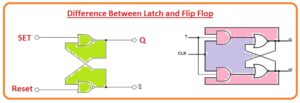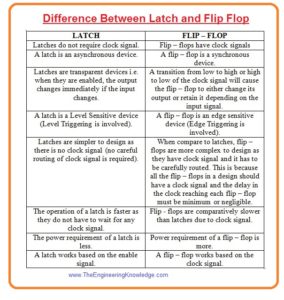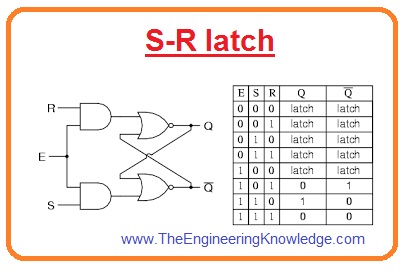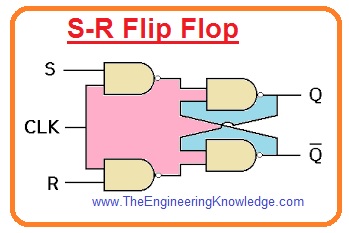 Hello fellows, I hope you all are doing great. In today’s tutorial, we will have a look at Difference Between Latch and Flip Flop. The latches and flip-flops are called basic elements of electronic networks. latch varies its output according to a given input signal when it is enabled. While in flip flop the output varies according to the conjunction input with the clock signal. In simple words, the clock signal is working as a control signal to show the output according to variations in the input.
Hello fellows, I hope you all are doing great. In today’s tutorial, we will have a look at Difference Between Latch and Flip Flop. The latches and flip-flops are called basic elements of electronic networks. latch varies its output according to a given input signal when it is enabled. While in flip flop the output varies according to the conjunction input with the clock signal. In simple words, the clock signal is working as a control signal to show the output according to variations in the input.
As we know that memory chips, logic circuits, and microprocessors are digital ICs that store and send information in the shape of bits. So these are called basic building blocks of electronic networks. Due to this latch and flip flop are known as derived series circuitry which works for the storage of information. In today’s post, we will have a detailed look at both latch and flip flops and compare them to find their differences. So let’s get started with Difference Between Latch and Flip Flop.
Difference Between Latch and Flip Flop
Latch
- Its working principle depends on the level triggering.
- It is constructed with the logic gates.
- Its working depends on the applied inputs, applying input, and given output value in binary numbers.
- When it is enabled show sensitivity for an applied signal.
- There is less power required to operate it.
- Its operating speed is high.
- Most common types of Latches are S-R, J-K, T and D.
- It can not be used as register.
- It need less place for operation.
- there is no need of a clock signal for its operation.
- Its circuit analysis is complicated.
- Its robustness is low.
Flip Flop
- Its working operation depends on the edge-triggering technique.
- It is constructed with clocks.
- It can not be used as register.
- It circuit analysis is easy.
- Its operation depends on the applying input, applying inputs, and obtained analog output with the pulses of the clock.
- It needs a large operating area.
- It required a clock signal.
- It required large power for operation than a latch.
- Its operation speed is low.
- It performed synchronous operations.
- The types of flip flops are S-R, J-K, T and D.
Types of Flip Flops
| Flip-Flop Type | Characteristics |
|---|---|
| SR Flip-Flop | Has two inputs: Set and Reset |
| D Flip-Flop | Has a single input: Data (D) |
| JK Flip-Flop | Has two inputs: J and K, with toggle functionality |
| T Flip-Flop | Has a single input: Toggle (T), also called a “T” or “toggle” flip-flop |
| Master-Slave Flip-Flop | Consists of two gated SR flip-flops, with one serving as the “master” and the other as the “slave” |
What is Latch
- The latches are series logic circuitry which is constructed with the use of logic gates and used for storage of information in the form of binary numbers.
- This module is level triggered so functions only when it is enabled.
- It also called a bistable multi-vibrator since it has 2 stable states.
- Its operation is that when enabling pin out is active then variation in the input, and output varied.
- In simple word the variation in input stored data also varied.
- In the below figure you can see the S-R latch logic circuit.
- In this configuration when enable signal is on the variation in input changes the stored binary information. Due to this it is known as level sensitive.
What is Flip Flop
- Flip flops are known as series logic circuitry since their current output depends on the applied input, applying input, and obtained output.
- But contrary to the latch most important role of in the operation of flip-flop is a clock.
- Therefore, for flip-flop when input varied from one level to another then the stored bits varied only when the clock is changed from one level to another.
- In below figure you can see the S-R flip flop.
- So in simple words, flip-flop varies the output with respect to input but with the change in the clock signal.
- Therefore clock signal is the control signal in this case and therefore the output of flip flop take some time.
SR flip flop vs JK flip-flop
| SR Flip-Flop | JK Flip-Flop |
|---|---|
| It has two inputs set and reset | Its two inputs are J and K |
| it has the ability to implement through the use of NOR or NAND gates | It is implemented with AND gates and NOT gates |
| Active high inputs: S and R are one for set and reset of flip flop | Active high inputs: J and K have one value for the set and reset flip-flop |
| Active low inputs: S and R are zero for retaining the current state | Active low inputs: J and K are zero for retaining current conditions |
| It can be used for the creation of other flip flops like D and T types of flip flop | It is used for the creation of D and T flip flops |
| Its output is not consistent so not used for circuits where both inputs are active at same time | Useful in circuits when both inputs are active at the same time because the output switches between states |
Latch vs Flip-Flop
| Latches | Flip-Flops |
|---|---|
| Latches are level-sensitive | Flip-flops are edge-triggered |
| Latches are asynchronous devices | Flip-flops are synchronous devices |
| Latches can be transparent or opaque | Flip-flops are always opaque |
| Latches can have one or two stable states | Flip-flops have two stable states: 0 and 1 |
| Latches are used for small data storage | Flip-flops are used for counters, data registers, and state machines |
| Latches are simpler and consume less power | Flip-flops are more complex and consume more power |
FAQs
- Can we trigger the latch by a clock signal?
- No, latches can be triggered through use of a continuous signal since they use feedback for state retaining
- Write the difference between a gated latch and a D latch.
- A gate latch gets triggered through the use of a gate input and D latch through enabling input
- Write the benefits of using a flip-flop over a latch.
- Flip flops are reliable for the timing issues
- Write the difference between JK flip-flop and SR flip-flop? .
- An SR flip flop comes with two inputs (Set and Reset), whereas a JK flip flop has two inputs (J and K) with added functionality that allows for toggling.
- What are the main applications for flip-flops?
- Their main applications are counters, data registers, and state machines.
That is a detailed post about the Difference Between a Latch and Flip Flop if you have any questions ask in the comments. Thanks for reading.









